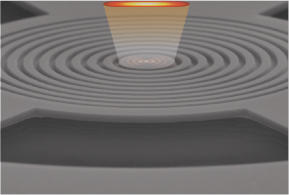CNST Researchers Use Nanophotonics to More Efficiently Extract Photons from Single Semiconductor Quantum Dots

An international team of researchers led by the CNST has developed a new type of nanophotonic cavity that improves the efficiency of photon collection from individual quantum dots while enhancing the photon emission rate. Single semiconductor quantum dots grown epitaxially on a substrate could be bright and stable sources of "on demand" single photons for many applications in spectroscopy and classical and quantum information processing. However, the application of such quantum dots has been limited by the relatively small fraction of the emitted light (< 1 %) that can be collected by nearby lenses because of optical effects, including total internal reflection of the light at the semiconductor-air interface. Different types of nanophotonic structures have been fabricated to enhance the emission and/or collection of the light, but each typically introduces other limitations, such as operation over a very narrow spectral band. The team of researchers from NIST, the University of Maryland, the University of Regensburg, and the University of Rochester has developed a nanophotonic structure that increases the emission and collection of quantum dot photons while maintaining relatively broadband operation. The new device consists of a suspended 200 nm-thick GaAs membrane that contains embedded quantum dots and into which a circular dielectric grating is partially etched. The asymmetric nature of the grating leads to preferential emission of quantum dot photons out of the surface, resulting in a practical collection efficiency of ≈ 10 % with simple optics — a 20× improvement over collection from unpatterned GaAs. In addition, the device enhances the emission rate by a factor of four and operates with ≈ 5 nm bandwidth. Simulations show that optimizing the fabrication and optics could allow a collection > 80 %, giving this approach great potential for creating bright single-photon sources.
A circular dielectric grating for vertical extraction of single quantum dot emission, M. Davanco, M. T. Rakher, D. Schuh, A. Badolato, and K. Srinivasan, Applied Physics Letters 99, 041102 (2011).

